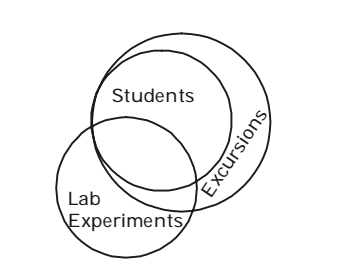Syllogism
Direction: Two statements are given followed by four conclusions I,II, and IV. You have to consider the statements to be true even if they seem to be at variance from commonly known facts. You are to decide which of the given conclusions, if any, follow from the given statements. Indicate your answer.
- Statements:
(a) All dogs are books
(b) All books are pictures.
Conclusion:
I. All dogs are pictures.
II. All books are dogs.
III. All pictures are dogs.
IV. Some pictures are books.
-
View Hint View Answer Discuss in Forum
Both the Premises are Universal Affirmative (A-type).
All dogs are books. ↔ All books are pictures.Correct Option: A
Both the Premises are Universal Affirmative (A-type).
All dogs are books. ↔ All books are pictures.
A + A ⇒ A-type of Conclusion “All dogs are pictures.”
This is Conclusion I.
Conclusion IV is Converse of the second Premise.
Direction: Three statements are given followed by four conclusions I, II, III and IV. You have to consider the statements to be true even if they seem to be at variance from commonly known facts. You are to decide which of the given conclusions, if any, follow from the given statements. Indicate your answer.
- Statements:
(a) All books are boxes.
(b) All boxes are pens.
(c) All pens are papers.
Conclusions:
I. Some papers are books.
II. All books are papers.
III. Some pens are books.
IV. All boxes are books.
-
View Hint View Answer Discuss in Forum
All the three statements are Universal Affirmative (A-type).
All books are boxes. ↔ All boxes are pens.Correct Option: C
All the three statements are Universal Affirmative (A-type).
All books are boxes. ↔ All boxes are pens.
A + A ⇒ A-type of Conclusion “All books are pens.”
Conclusion III is Converse of it.
All books are pens. ↔All pens are papers.
A + A ⇒ A-type of Conclusion “All books are papers.”
This is Conclusion II.
Conclusion I is Converse of it.
All boxes are pens. ↔ All pens are papers.
A + A ⇒ A-type of Conclusion “All boxes are papers.”
Direction: Two statements are given followed by four conclusions (I), (II), (III) and (IV). You have to consider the statements to be true even if they seem to be at variance from commonly known facts. You are to decide which of the given conclusions, if any, follow from the given statements. Indicate your answer.
- Statements:
Some teachers are students.
All students are girls.
Conclusions:
(I) All teachers are girls.
(II) Some girls are teachers.
(III) Some girls are students.
(IV) All students are teachers.
-
View Hint View Answer Discuss in Forum
First Premise is Particular Affirmative (I-type).
Second Premise is Universal Affirmative (A-type).
Some teachers are students. ↔ All students are girls.Correct Option: C
First Premise is Particular Affirmative (I-type).
Second Premise is Universal Affirmative (A-type).
Some teachers are students. ↔ All students are girls.
I + A ⇒ I-type of Conclusion “Some teachers are girls”.
Conclusion II is Converse of it.
Conclusion III is Converse of the second Premise.
Direction: One/Two Statement(s) is/are given followed by two Conclusions, I and II. You have to consider the statement(s) to be true, even if it/they seem(s) to be at variance from commonly known facts. You are to decide which of the given conclusions can definitely be drawn from the given statement(s). Indicate your answer.
- Statement:
(a) All students like excursions.
(b) Some students like laboratory experiments.
Conclusions:
(I) Students who like laboratory experiments also like excursions.
(II) Some students do not like laboratory experiments but like excursions.
-
View Hint View Answer Discuss in Forum
Draw a figure and solve the question.
Correct Option: C
The given statements can be illustrated as:

Direction: In each of the following questions one/two statements are given followed by two conclusions and assumptions (I) and (II).You have to consider the two statements to be true even if they seem to be at variance from commonly known facts. You have to decide which of the given conclusions and assumptions, if any, follow from the given statement.
- Statements:
All hens are cocks.
No cock is black.
Conclusions:
I. All cocks are hens.
II. No hen is black.
-
View Hint View Answer Discuss in Forum
All hens are cocks. (A) ↔ No cock is black. (E)
Correct Option: B
All hens are cocks. (A) ↔ No cock is black. (E)
A + E → E- type of conclusion “No hen is black.”
This is Conclusion II.

